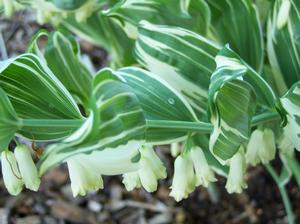View All Plants :: View All SHADE PERENNIALS
Polygonatum x hybridum 'Grace Barker'
Solomon's Seal
Plant Type:
SHADE PERENNIALSPolygonatum x hybridum 'Grace Barker' – This is a very nice P. multiflorum x odoratum cultivar sporting dark green to blue-green alternate ovate leaves with moderate undulations and striations on arching stems. The variegations vary from leaf to leaf – some replete with many pinstripes while on others broader white patches occur. White bell flowers dangle in spring. from All in all 'Grace Barker' is a excellent addition to the woodland garden. Plant her in fertile soil sited in shade to dappled conditions. 'Grace Barker' clumps with moderate increase. Pot Grown but shipped bare root.
Characteristics and Attributes for Polygonatum x hybridum 'Grace Barker'
Season of Interest (Flowering)
- Spring
Season of Interest (Foliage)
- Spring / Summer / into Autumn
Nature Attraction
- Deer Resistant
Light
- Dappled Shade
- Shade
Attributes
- Border
- Ground Cover
- Woodland
Growth Rate in the Garden
- Medium
Soil
- Fertile
- Draining
Origins
- Garden Origin
Propagated By
- Division
Genus Overview: Polygonatum
Common Name: Solomon's Seal
These are the architectural Solomon Seals, all strong contrasting counterpoint to other denizens in the woodland/shade garden. Solomon Seals form spectacular colonies of upright arching stems from rhizomes just under the surface soil and leaf duff. Allan Armitage writes in his 2nd edition of Herbaceous Perennial Plants, “The common name Solomon’s Seal may have been derived from the circular sunken scars that remain on the rootstock after the leaf stalks die and fall off; the scar somewhat resembles a seal impressed on wax on official documents or letters in former times.” The simple leaves are obovate to elliptic turning yellow to golden brown in autumn before dropping. All prefer open shade to morning sun. When flowers are pollinated dangling blue fruits may develop on short paired pedicels along stems from leaf axils. All of the following offerings are by pot grown established division.


